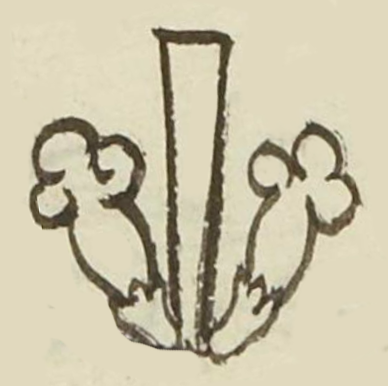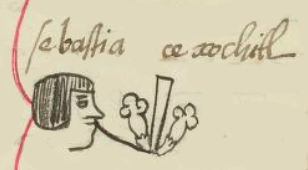Ce Xochitl (MH908r)
This black-line drawing of the simplex glyph for the personal name Ce Xochitl (“One Flower” or “1-Flower”) is attested here as a man’s name. The glyph shows two three-petaled flowers, each one with a stem base. Coming up between the two flowers (xochitl) is the counter for the number one (ce). It is a rectangular bar, somewhat taller than the flowers. This is a calendrical name based on the tonalpohualli, a 260-day religious divinatory calendar, which here combines the day name xochitl with the notation of one. Interestingly, we have two flowers, and this makes more sense than it might seem, because the notation of one is not meant to count the flower as one. It is a numerical companion to the day name.
Stephanie Wood
Tonalpohualli names were being discouraged by the colonial clergy, and yet here we see the persistence of some of these names. This one still has both the day name and the notational companion. But in other examples, one will find just a number or just a day name, perhaps as a result of forgetting, just abbreviating, or a type of subterfuge to avoid clerical disapproval. See comparisons, below, where Ce Xochitl sometimes has the notation and sometimes just involves a single flower. Is the latter a form of forgetting that the number did not intend to count the flower?
Stephanie Wood
Sebastia ce xochitl
Sebastian Ce Xochitl
Stephanie Wood
1560
Jeff Haskett-Wood
flores, números, uno, calendarios, nombres de días, nombres de hombres

ce, one, https://nahuatl.wired-humanities.org/content/ce
xoch(itl), flowers, https://nahuatl.wired-humanities.org/content/xochitl
Uno-Flor, o 1-Flor
Stephanie Wood
Matrícula de Huexotzinco, folio 908r, World Digital Library, https://www.loc.gov/resource/gdcwdl.wdl_15282/?sp=886&st=image.
This manuscript is hosted by the Library of Congress and the World Digital Library; used here with the Creative Commons, “Attribution-NonCommercial-ShareAlike 3.0 License” (CC-BY-NC-SAq 3.0).





